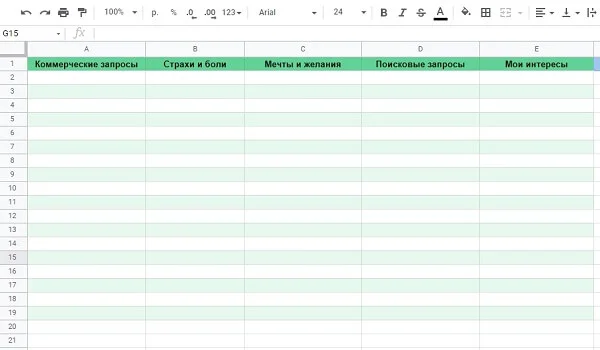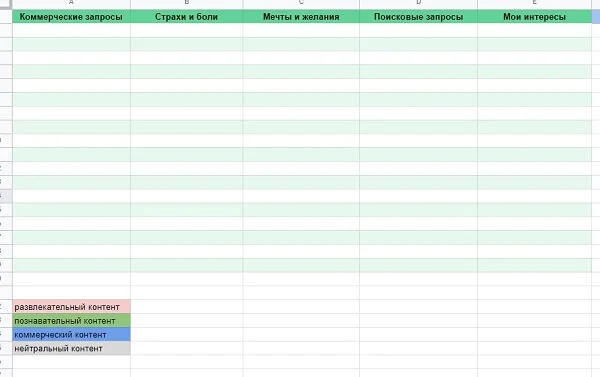Step 1. Create a table
First, you need to create an Excel table with five columns, where you can enter the information and then work with it:
- The first column is for the business needs of your target audience. That is where you write questions and requests are related to a product, blog, or your target audience.
- The second column is for fears and pains. Here you write down everything related to fears, pains, and experiences — what your target audience is afraid of. If you do not yet have a portrait of the target audience, you need to make it first and then start dealing with the content plan, and not vice versa.
- The next column is for dreams and desires: what your audience dreams about, wants, what their wishes are about, and what they admire. It is necessary to write down positive things. You can also jot down ideas, caps, topics, fields.
- The fourth column is for search requests. When you start typing something in Yandex or Google, you see hints in the drop-down list: what users are looking for, how they formulate their thoughts. You should check and look at these tips, try to type in different formats of requests, articles, questions, something related to your product or goals, tasks, topics. Try to enter words and phrases in as many ways as possible. Learn search tips from YouTube, Yandex, Google. In addition to the tips, you can check core requests and trends, for example, how many people are looking for the specific information. Google has the Google Trends tool, and Yandex has WordStat. They are special features that allow you to view statistics for keywords.
- In the last column, you should write down things interesting to you as a business owner, blog author, expert, or SMM specialist.

So, you have a five-column table. Next, you need to choose those requests that are the same in all five columns. These are vital requests because they meet all the requirements: they are attractive for the target audience, interesting to you, people are searching for them on the Internet, this information brings you closer to your goal in terms of selling things or getting new followers.
Try to find as many repeated words, requests, ideas from different columns as possible. The more often they are used, the better each field will work, and the content will be efficient, attractive, and in demand.
Step 2. Determine the content type
Next, you need to divide all the content you have into types. There are four main types of content.
- Entertaining. That is content that evokes emotions. It does not help teach something, sell something, talk about something, and discuss news.
- Informative or helpful. This content shares utility things, creates a particular value, answers questions, gives information, teaches something, and answers users’ questions and requests.
- Commercial. It can be direct advertising, native integration, or veiled commercial content. The third type of content is aimed at making sales and performing targeted actions that are necessary for your business or blog.
- Neutral content. There may be just news and trending situations. Content that you cannot attribute to any of the first three types.

Write down these four types of content in a table and mark them: for example, entertainment content — in pink, informative content — in green, commercial content — in blue, and neutral content — in gray.
Step 3. Select Categories
What you get: you have a table where you wrote down a bunch of different ideas, then labeled them, and understood which one belongs to which type of content. Your task is to try to create caps from all that all: for example, articles, reviews, questions, and answers, live broadcasts, quest games, and so on.
Try to think of as many caps as possible. A cap means that you can constantly generate some content on a specific topic.
Then give each rubric a different color. Decide what it will be - entertaining, informative, purely commercial. There may already be several colors here. For example, one rubric can be informative-entertaining, entertaining-commercial, or vice versa - informative-commercial.

Step 4. Content timeline
Now that you have ideas and caps, you only need to distribute the content in terms of the timeline. You can use different approaches for this. You can make a monthly plan. In this case, you distribute content by day of the week. For example, on Monday, you have one cap, on Tuesday — the second one, on Wednesday — cap number three, and so on.
Important rules for categorizing rubrics:
- alternate caps to create various content;
- add information to the table about what type of content you should use: video, article, photos, small note;
- you can add information about the content next to the rubric: photo, video, short video, long video, article, photo selection, and so on;
- alternate caps by type of content as well: a video, a photo selection, a long article, a short article, a video review, and then again — a photo selection. That is vital not to let users get bored. The more varied your content is, the better it works.
Frequency of content publishing: create as much content as you can. If you can shoot high-quality videos for your YouTube channel every day — do it every day. If you make two videos a week, it is all right — create two videos a week. But do not make fewer than that. Quality is the key.
The benefits of this approach
Why would such a content plan work well, and why not use templated content?
This way, you create a table and a content plan specifically for your project — your requests and the interests of the target audience. You also pay attention to what people are looking for on the Internet. These questions may be obvious to you, but not to other people, which means that they will search for this information.
Also, remember your desires and interests, do not forget about what you are interested in and willing to share. If you put it all together and find common topics, it will all work great. It will be interesting to you — so you will create good content. And your followers and your target audience will be happy to read and interact with this content because they are also interested and care about it.





